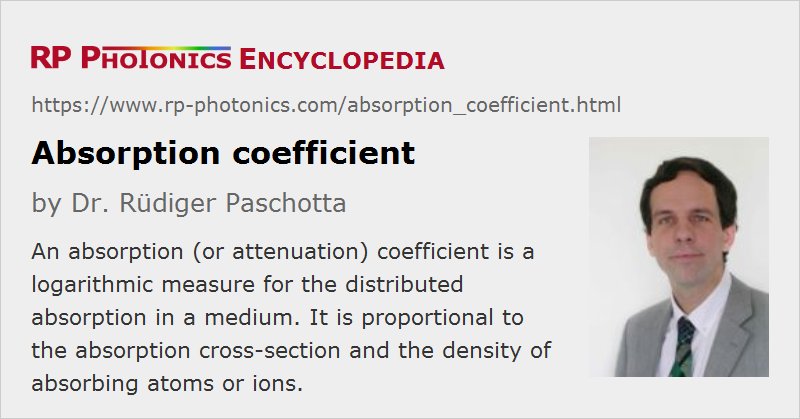Absorption Coefficient
Definition: a logarithmic measure for the distributed absorption in a medium
Alternative term: attenuation coefficient
German: Absorptionskoeffizient
Formula symbol: α
Units: m−1, cm−1
How to cite the article; suggest additional literature
Author: Dr. Rüdiger Paschotta
The absorption of light per unit length in a medium is often quantified with an absorption coefficient α, also called attenuation coefficient. For a short propagation length z, where the overall absorption is small, the absorbed power for an incident power Pin is approximately α z Pin, and the total transmittance is approximately 1 − α z. For longer propagation lengths, the transmittance is exp(−α z).
Note that sometimes one uses absorption coefficients for field amplitudes instead of optical powers or intensities. These are two times smaller than the corresponding intensity absorption coefficients, because the intensity is proportional to the square of a field amplitude.
In some cases, one uses a decadic absorption coefficient, which is smaller by the factor ln 10, so that the absorbance is simply that coefficient times the optical path length.
Relation to Microscopic Properties
If an absorption is caused by absorbing atoms or ions (for example, dopant ions in some transparent glass or crystalline material), the absorption coefficient is the product of the doping density (in units of m−3) and the absorption cross section (in units of m2) at the relevant optical wavelength.
Questions and Comments from Users
Here you can submit questions and comments. As far as they get accepted by the author, they will appear above this paragraph together with the author’s answer. The author will decide on acceptance based on certain criteria. Essentially, the issue must be of sufficiently broad interest.
Please do not enter personal data here; we would otherwise delete it soon. (See also our privacy declaration.) If you wish to receive personal feedback or consultancy from the author, please contact him e.g. via e-mail.
By submitting the information, you give your consent to the potential publication of your inputs on our website according to our rules. (If you later retract your consent, we will delete those inputs.) As your inputs are first reviewed by the author, they may be published with some delay.
See also: absorption, absorbance, transition cross sections
and other articles in the category general optics
 |



If you like this page, please share the link with your friends and colleagues, e.g. via social media:
These sharing buttons are implemented in a privacy-friendly way!